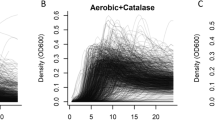Abstract
Two of 23 strains ofHelicobacter pylori adapted from microaerobic to aerobic growth on blood agar plates incubated in humidified air. The airadapted strains remained urease and phenylalanine deaminase positive and did not require the buffering effect of an enriched CO2 atmosphere for growth. The significance of this phenomenon remains to be determined as the two strains capable of aerobic metabolism were laboratory-adapted.
Similar content being viewed by others
References
Marshall BJ, Royce H, Annear DI, Goodwin CS, Pearman JW, Warren JR, Armstrong JA Original isolation ofCampylobacter pyloridis from human gastric mucosa. Microbios Letters 1984, 25: 83–88.
Barrow GI, Feltham RKA Cowan and Steel's manual for the identification of medical bacteria. Cambridge University Press, Cambridge, 1993.
Tompkins DS Isolation and characteristics ofHelicobacter pylori. In: Rathbone BJ, Heatley RV (ed):Helicobacter pylori and gastroduodenal disease. Blackwell, Oxford, 1992, p. 19–28.
Goodwin CS, Armstrong JA Microbiological aspects ofHelicobacter pylori (Campylobacter pylori). European Journal of Clinical Microbiology & Infectious Diseases 1990, 9: 1–13.
Jones DM, Sutcliffe EM, Rios R, Fox AJ, Curry A Campylobacter jejuni adapts to aerobic metabolism in the environment. Journal of Medical Microbiology 1993, 38: 145–150.
Catrenich CE, Makin KM Characterisation of the morphologic conversion ofHelicobacter pylori from bacillary to coccoid forms. Scandinavian Journal of Gastroenterology 1991, 26, Supplement 181: 58–64.
Clayton CL, Kleanthous H, Dent JC, McNulty CAM, Tabaqchali S Evaluation of fingerprinting methods for identification ofHelicobacter pylori strains. European Journal of Clinical Microbiology & Infectious Diseases 1991, 10: 1040–1047.
Ho SA, Hoyle JA, Lewis FA, Secker DA, Cross D, Mapstone NP, Dixon MF, Wyatt JI, Tompkins DS, Taylor GR, Quirke P Direct polymerase chain reaction test for detection ofHelicobacter pylori in humans and animals. Journal of Clinical Microbiology 1991, 29: 2543–2549.
Cederbrant G, Kahlmeter G, Ljungh Å Proposed mechanism for metronidazole resistance inHelicobacter pylori. Journal of Antimicrobial Chemotherapy 1992, 29: 115–120.
Jones DM, Sutcliffe EM, Curry A Recovery of viable but non-culturableCampylobacter jejuni. Journal of General Microbiology 1991, 137: 2477–2482.
West AP, Millar MR, Tompkins DS Effect of physical environment on survival ofHelicobacter pylori. Journal of Clinical Pathology 1992, 45: 228–231.
Author information
Authors and Affiliations
Rights and permissions
About this article
Cite this article
Tompkins, D.S., Dave, J. & Mapstone, N.P. Adaptation ofHelicobacter pylori to aerobic growth. Eur. J. Clin. Microbiol. Infect. Dis. 13, 409–412 (1994). https://doi.org/10.1007/BF01971999
Issue Date:
DOI: https://doi.org/10.1007/BF01971999




